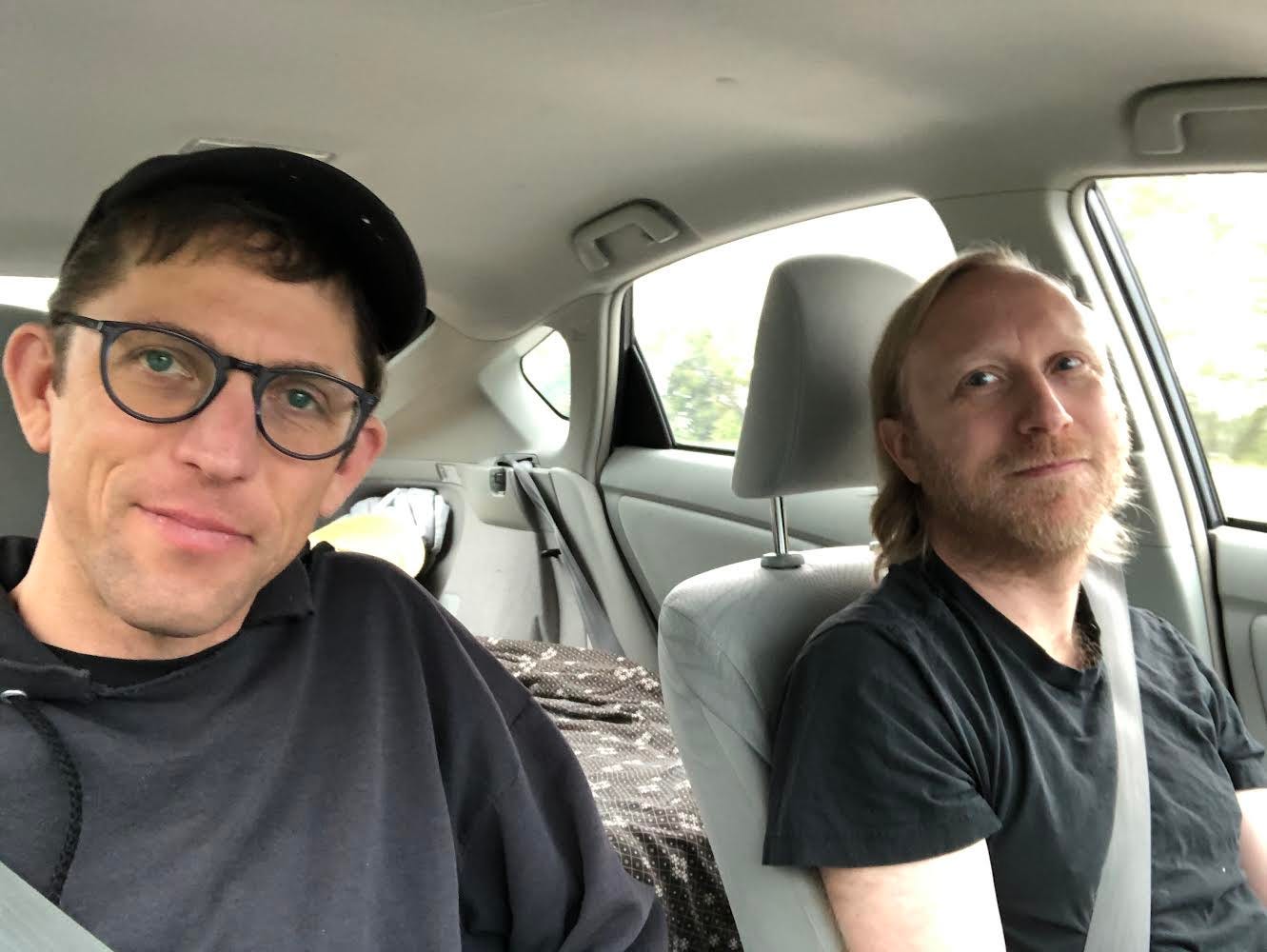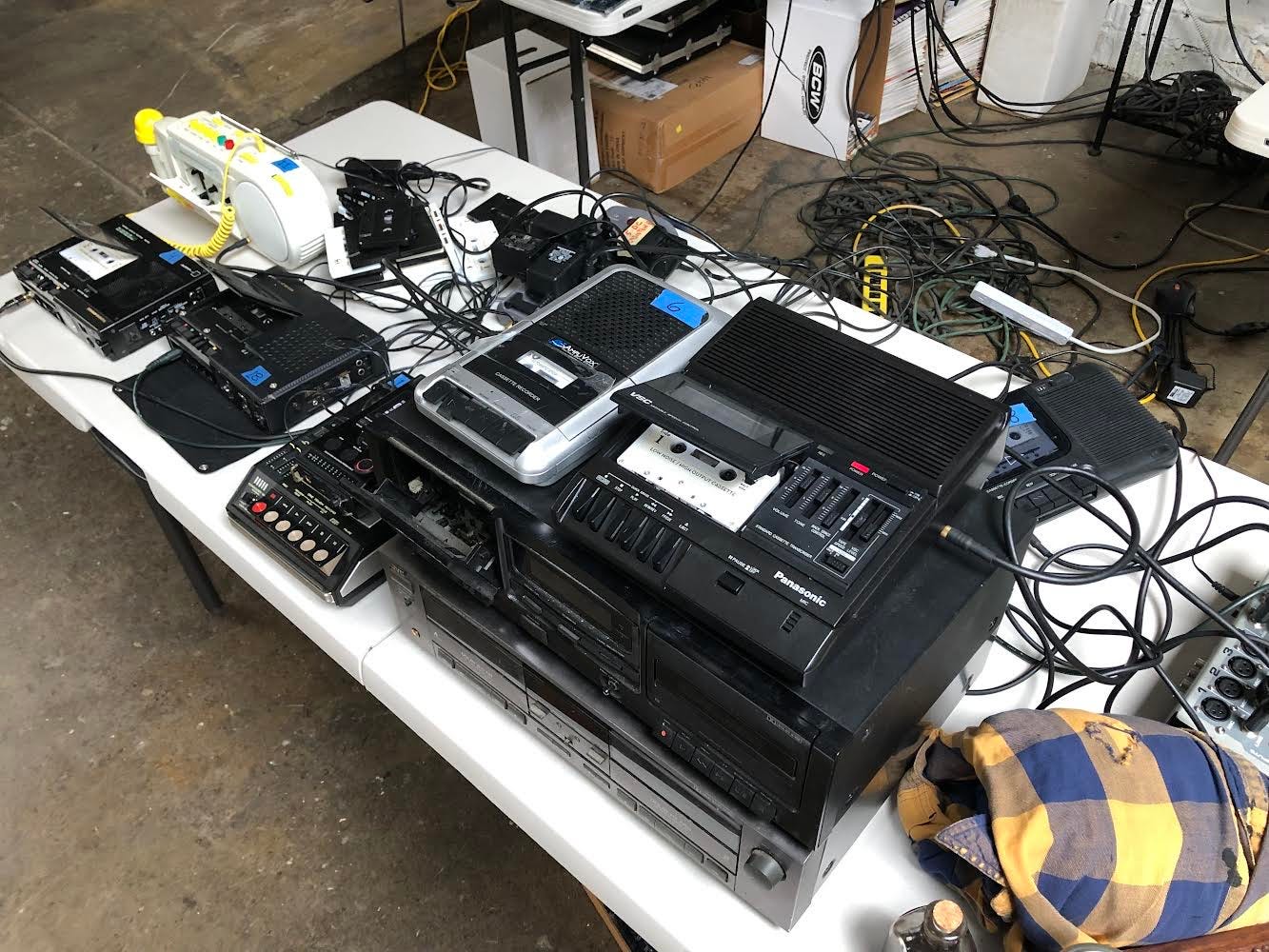Ghost Signals
Patrick Much talks about "7 Intuitions 5"
This Friday, from sunrise to sunrise on the following morning, the musicians Patrick Murch and JM Borer will perform “7 Intuitions 5” at the Berkeley Alembic. It will be the fifth iteration of an ongoing series of extended form audio pieces. Over these 24 hours, Murch and Borer will build an immersive and ongoing drone environment designed to open spectral channels of communication. Acoustic and electronic sources will be recorded live onto cassette, and then re-recorded and layered into a sonic psycho-geography of the extraordinary. In the following interview, Patrick talks more about the piece and its origins in the work of memory, loss, and magnetic tape.
Erik Davis: This will be the fourth time you have performed “7 Intuitions” live. The first time you did it though was for a recording project. What motivated that initial piece?
Patrick Murch: I had been asked to do a piece for an online magazine dedicated to sound art called Soap Ear. I was going back through my old cassettes and had stumbled across some recordings I had done with my friend Philip Kruse. Philip was probably the first person I started collaborating with around noise and experimental stuff. Unfortunately he passed away in 2016. So in 2018, when I started this Soap Ear project, I was reflecting on the work we had done together while rediscovering some of the recordings that we had made. I assembled the piece more in a ritualistic way, rather than a musically compositional way.
ED: Can you say more about that process?
PM: The main recording that I used was a drone recording that Philip and I had made on an organ that was in our shared house in Portland, Oregon. I think that recording was made in 2007 or 2008, so basically it had been shelved for ten years. I hadn't listened to it or thought about it in a while. We had made a lot of loop tapes and things that we intended to use for projects that either never came to be or that we decided didn’t fit with the projects we were working on. As I started to assemble these recordings into something new, I started to feel the kinship that we had when he was alive and we were working on things together. So in the process of making the piece, I developed the idea that the work was a continuation of our collaboration — a communication with him beyond time and space, I suppose.
At the same time, I was reading about the electronic and scientific process behind radio waves. I learned that radio waves were a naturally occurring part of our planet, that they existed before we had tapped into them and learned how to use them to send signals back and forth. Sine waves, which are essentially drones, are used to carry messages — the audio, the music, the speech, whatever it is — from one place to another just by tuning into certain frequencies with a radio dial. I started to feel a strong correlation between that and what I was working on. And so I developed the idea that the piece was tapping into, not necessarily a radio wave, but something akin to that, something in the spirit world, I suppose, or in between our conscious world and the unconscious one that we discover through meditation or ritual or what have you.
ED: So the music becomes a carrier wave for something else, something more mysterious. Do you think about these live performances as rituals, seances, experiments, or something else?
PM: Just by virtue of the event lasting for 24 hours, I consider it less as a show, and more as a ritual, or at least a happening or situation. The first time I performed it, it was with my friend Justin Borer, who will also be with me on Friday. Philip and Justin and I played in a band together in our late teens and early 20s. So it felt natural to ask him to do this piece with me. The first time we performed it in 2019 in Los Angeles, we dressed up the environment with fake flowers, real flowers, dirt, and three colored panels, which were red, yellow, and blue. We did that to set a tone, and maybe make it easier for us and for the people there to get into a headspace and open up.
The decision to do it for 24 hours was an attempt to see whether, by adding a significant amount of time to the piece, it might be easier to open up unexpected channels. It wasn't just about communicating with the dead, but about opening up the possibility of communication with absolutely anything, whether it was people who have passed, people you've lost contact with but are still on this plane, or even fictional or mythical entities. And by giving this “radio signal” we were creating a definite physical location, it made it more like a radio tower. Since Justin and I are physically manipulating the situation, we would, in sense, become a conduit. Or we would ourselves become the radio tower.
ED: Can you say a little bit more about how you think about the room where the performance is taking place?
PM: I believe all physical entities have their own ghosts, so what a room or structure has experienced prior to the piece being performed there makes a difference. It allows for the possibility of a different interaction each time with the piece and how we guide it. Because in essence it's a very simplistic process, even a non-musical process. It’s just sounds that are being recorded, and then played back and recorded again, replayed into the space and recorded back on themselves so that the sound builds over time. The space itself guides the arcs and valleys of the piece. That sense of texture also involves the equipment that we use, which are cassette players, most of them sourced from thrift stores or off of Craigslist or what have you. As these kind of machines age, they develop their own peculiarities, their own characteristics, their own ghosts. They hold the dust and grime of the people who have used them before.
This goes back to the first time “7 Intuitions” was recorded. We used an old Tascam four-track cassette recorder that I have had since middle school. That’s the thing that Philip and Justin and I used to make our earliest recordings. It's suffered the test of time to a certain degree. It’s got its own tics and peculiarities, but I pulled it out to mix down that first recording. I was taken with the idea that Phillip’s essence is in that machine, as well as everyone’s who's used it. There's even a possibility that his DNA is there.
ED: Do you have any recommendations or suggestions for how listeners might approach this piece? People might be intrigued by all this, but are wondering, what's this going to be like?
PM: People can approach it any way that they like. It can be approached purely as a sound piece, one that comes from the lineage of drone music. We use acoustic and electronic sources to start the drone, and then we begin to layer it back on itself through the recordings. We’ll use a shruti box, the Indian instrument that’s like a harmonium but without a keyboard, just a pump box. We’ll also add an electronic shruti box, another Indian instrument. And this time we're also using a bowed acoustic guitar to try and bring in some different timbres.
The piece can also be approached in a spiritual manner, if what you're trying do is communicate, or sit with, or meditate on someone or something. It’ll hold space for that. We’ve had people add a physical element to it — not necessarily dance, but something less structured, like stretching or yoga or gentle movement. It's what I like to think of as both a quiet space and a loud space. Physically, it will at times be very loud, as the piece dictates to us. But mentally it is a very quiet space, especially for us after we've been doing it for a few hours. We kind of go blank in some way
ED: Is it even music at that point?
PM: Like I said, it's not necessarily a musical composition. As the piece progresses, we become more like operators or maintenance people. We're just pressing record on tape players, walking through the space, making sure the machines are working, observing when a tape stops. It kind of seems outside of a spiritual thing, but those super repetitive basic actions make you go a bit blank and get in tune with the space and the process. There's nothing else to do and there's nothing to rush about. There's no quick movements. Even if something breaks, we have multiple tape layers going, we can fix that or troubleshoot in a pretty stress-free way. A child could do what we're doing.
ED: Do you have any additional thoughts about performing “7 Intuitions 5” so near Halloween?
PM: As they say, the veil is thin during this time of year. A year or two before I first recorded this piece, a friend of mine named Carmina Escobar, an artist and experimental vocalist, asked me to perform at a Día de los Muertos celebration she was hosting. She had made an altar and invited people in a very loose fashion to perform in front of it. For my piece, I took a vinyl record of Philip’s music that he had released and I scratched symbols and lines into it. This was the year after he passed away. Without intending it, the patterning I created resembled a Snakes and Ladders thing. There were circular grooves and these slightly less deep grooves that connected them. When you played the record, the needle would go up and down, and then get stuck in these loops and just play essentially a drone in a short loop. Then it would catch itself and go down to another line, and move in its own automatic way. During this process, I had taken the record cover, which contained some of Philip’s artwork, and I tore it up and reassembled it more or less automatically.
Without explanation, I sent a video of the whole thing to Justin, who’s going to perform the piece with me this Friday. Without me saying anything, he immediately understood what the process was. I guess that doing “7 Intuitions” now, at this time of year, actually ties back to that initial piece. That Día de los Muertos record was the unconscious spark that got this all going, that inspired us to work with Philip again.
This interview has been edited for clarity.
Transmutations is a publication from the Berkeley Alembic, a center for consciousness culture that offers classes, workshops, retreats, and warm cups of tea. We grow by word of mouth, so feel free to share this if you are so moved.



